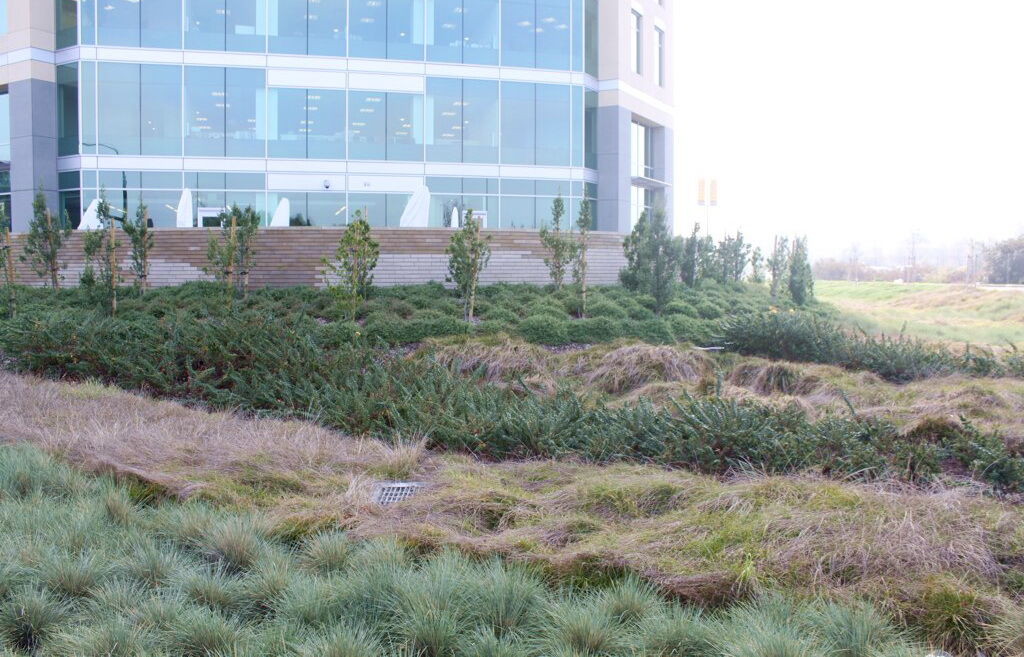Plant-Life and Water Retention
Create a Bio-retention Cell (Rain Garden)
What Is It?

Blue-Green Building
Rain gardens, bio-retention cells, and various urban wetlands use plants to treat and reduce stormwater runoff and increase soil infiltration. Natural biological and chemical processes can significantly reduce suspended solids and pollutants like nitrogen, phosphorous, and metals by 30-90%.
Rain gardens are typically smaller and positioned alongside roads and buildings while bioretention cells are often used in larger drainage areas. Multiple gardens and cells can be used for large drainage areas, though proper siting is extremely important to maximize effectiveness. A ‘micro urban wetland’ is a decentralized, modular system that can be adapted to a building, area, or community-level. In addition to collecting and filtering rainwater, as with rain gardens and bioretention cells, a micro urban wetland stores purified water in the ground to be recovered as needed.
Rain gardens should be located in sloped areas of up to 10% at least 10 feet away from building foundations and approximately one-third the size of the area providing the runoff. Bioretention cells should be located in landscaped or natural depressions not exceeding 6% slope and should be sized at approximately 5% of the drainage area, which should not exceed five acres. In addition to proper siting and sizing, sunlight requirements of the plant species used should be taken into consideration to maximize effectiveness and reduce maintenance.
Resilient native species that can survive in soaked soils should be used wherever possible. Salt-tolerant plants should also be used for drainage areas that are salted in winter. Design adjustments and combination with other stormwater best management practices and proper snow removal are necessary to ensure that bio-retention cells continue functioning during cold winters. Regular maintenance is required to ensure continued effectiveness and system longevity, including annual mulching, fertilizing, pruning, and removal of dead vegetation, as well as regular trash removal, weeding, and mowing.
Costs range significantly depending on plants used, landscaping required, and use of underdrains, liners, and outlet structures. In calculating cost savings from utilizing bioretention, it is important to take into account the reduction of conveyance and other conventional stormwater management systems and reduced maintenance, design, and liability costs: a medical office building in Maryland saved $24,000 through using bioretention in place of 570 additional feet of storm drain pipe.
Benefits
- Uses natural processes to reduce stormwater runoff volume, rate, and pollutants and increase soil and groundwater infiltration.
- Options, particularly with micro urban wetlands, can be customizable to variety of sizes based on site, budget, and intent.
- Green spaces used in rain gardens and bioretention can improve urban air quality, contribute to lower urban air temperatures, and be aesthetically pleasing.
- Can be easily retrofitted during any landscape modification or parking lot/street resurfacing.
- Maintenance costs of bioretention are lower than those of conventional stormwater management systems.
Drawbacks
- Bio-retention cells can take up significant land area; use in parking lots can reduce available parking.
- Can sometimes be more expensive than traditional stormwater management practices; adjustments needed to facilitate winter operation will increase installation costs.
- Careful landscaping and maintenance required; poor landscaping and maintenance can result in ineffective drainage and could attract pests.
Regulatory Impacts and Requirements
Potential regulatory touchpoints in Boston and Massachusetts include:
- Conservation Commission
- of Environmental Protection
- Boston Water and Sewer Commission
- Boston Groundwater Trust
Financing Options, Incentives, and Rebates
- Municipal stormwater abatement service fees – Municipal-level
- Coastal Pollutant Remediation (CPR) Grant Program – MA State
- Clean Water State Revolving Fund (SRF) – MA State
- Section 319 Nonpoint Source Competitive Grant – Funding provided under federal Clean Water Act
- 604b Water Quality Management Planning Grant – Funding provided under federal Clean Water Act
- Drinking Water Supply Protection Grant Program – MA State
NEWS
- "Howard County Banks on Rain Gardens to Raise Awareness of Stormwater Management" Baltimore Sun, August 2014
RESOURCES
- Prince Georges County, MD Dept. of Environmental Resources: Bioretention Manual
PROJECT EXAMPLES
A SAMPLE OF PROVIDERS
- Oldcastle
- Landscape designers/contractors (e.g. Land Escapes, FieldFactors)
- A list of plants native to Massachusetts coastal environments is available here
- A list of species appropriate for use in bioretention is available here


